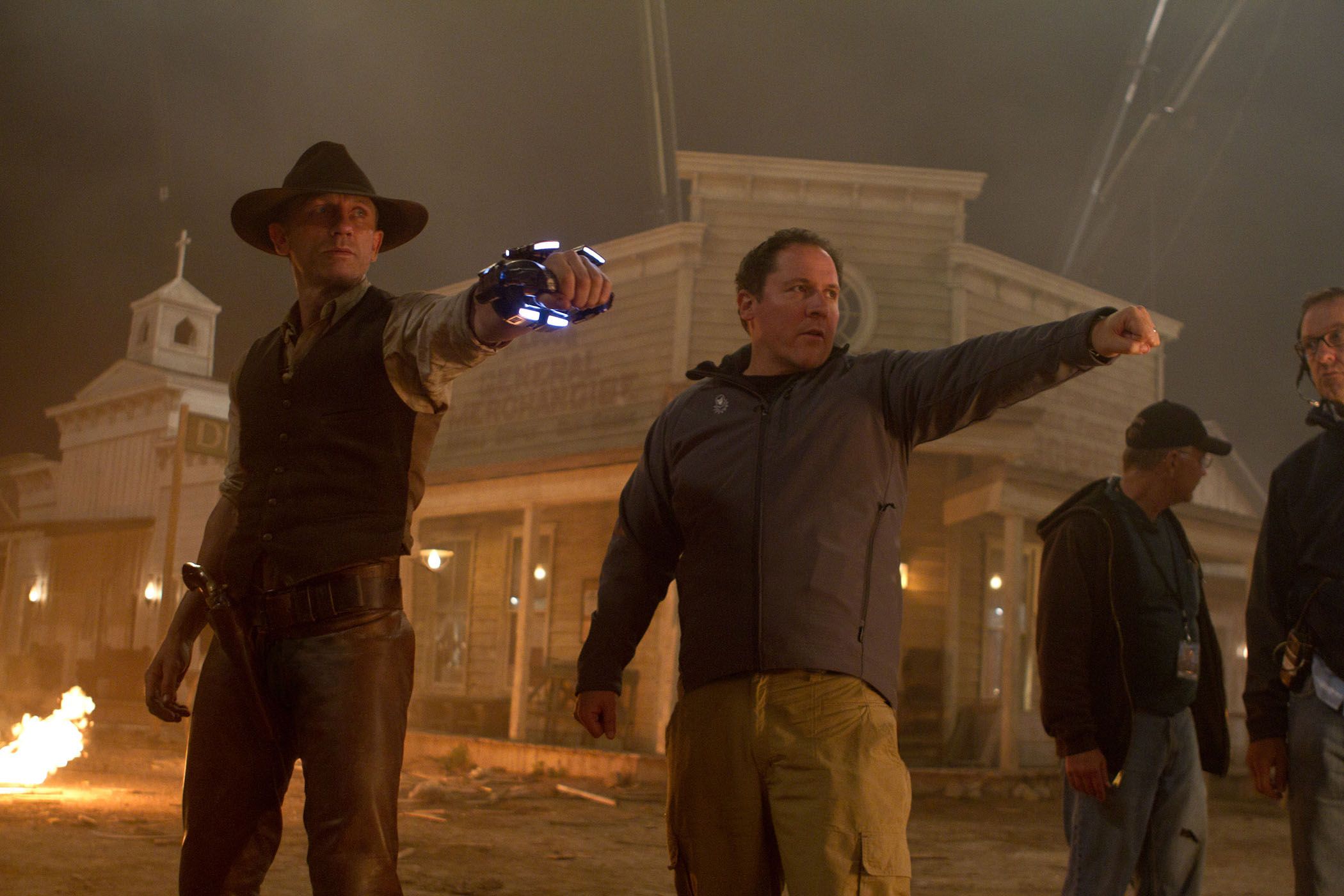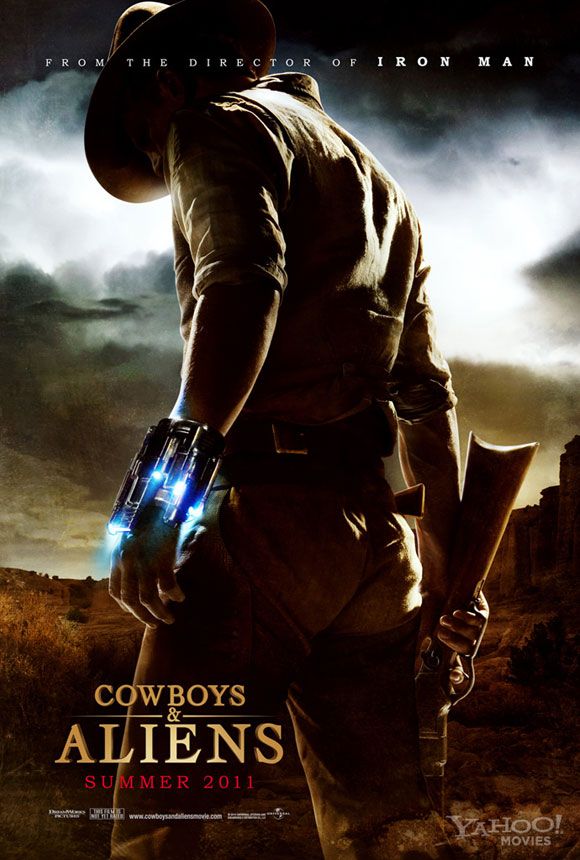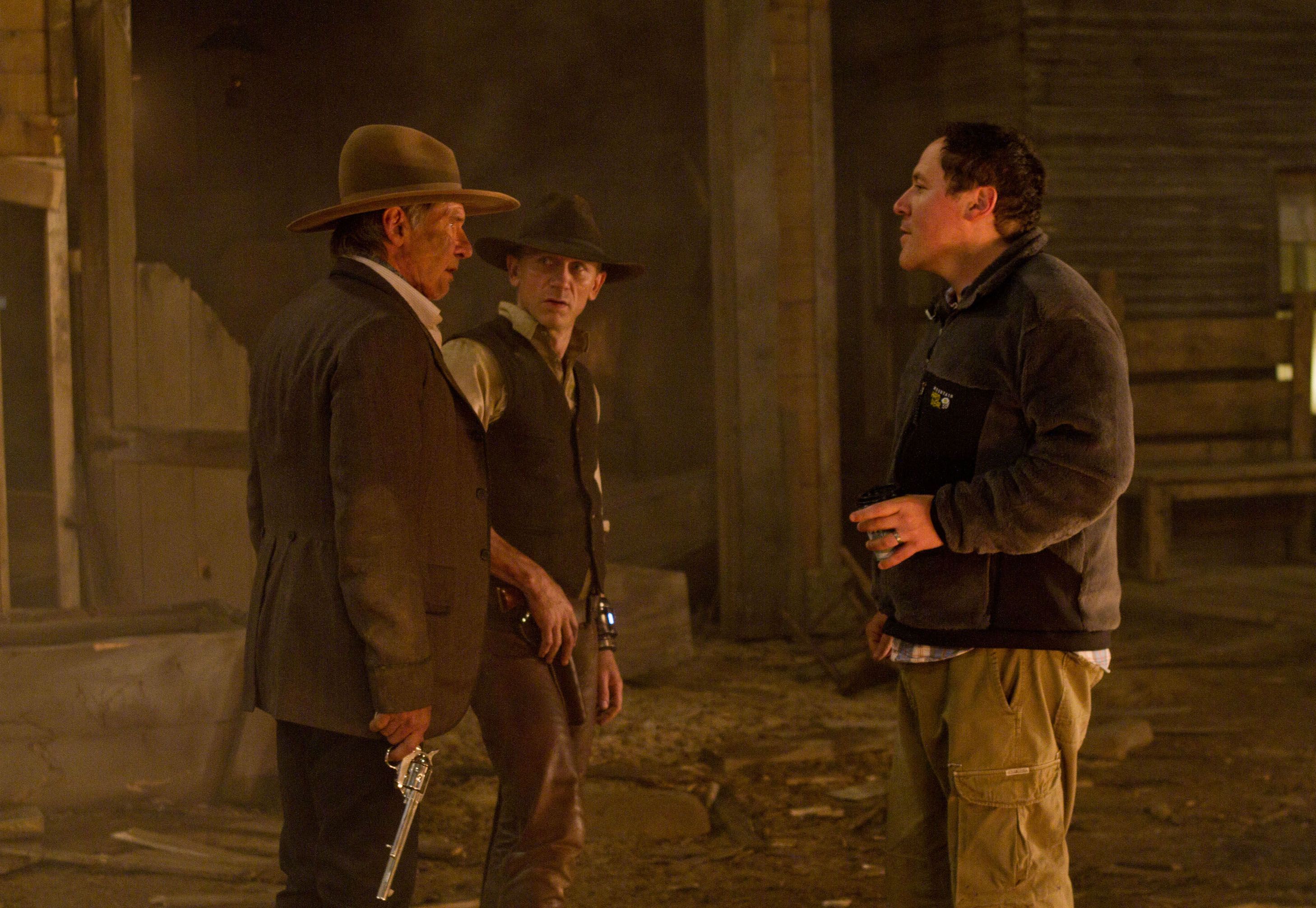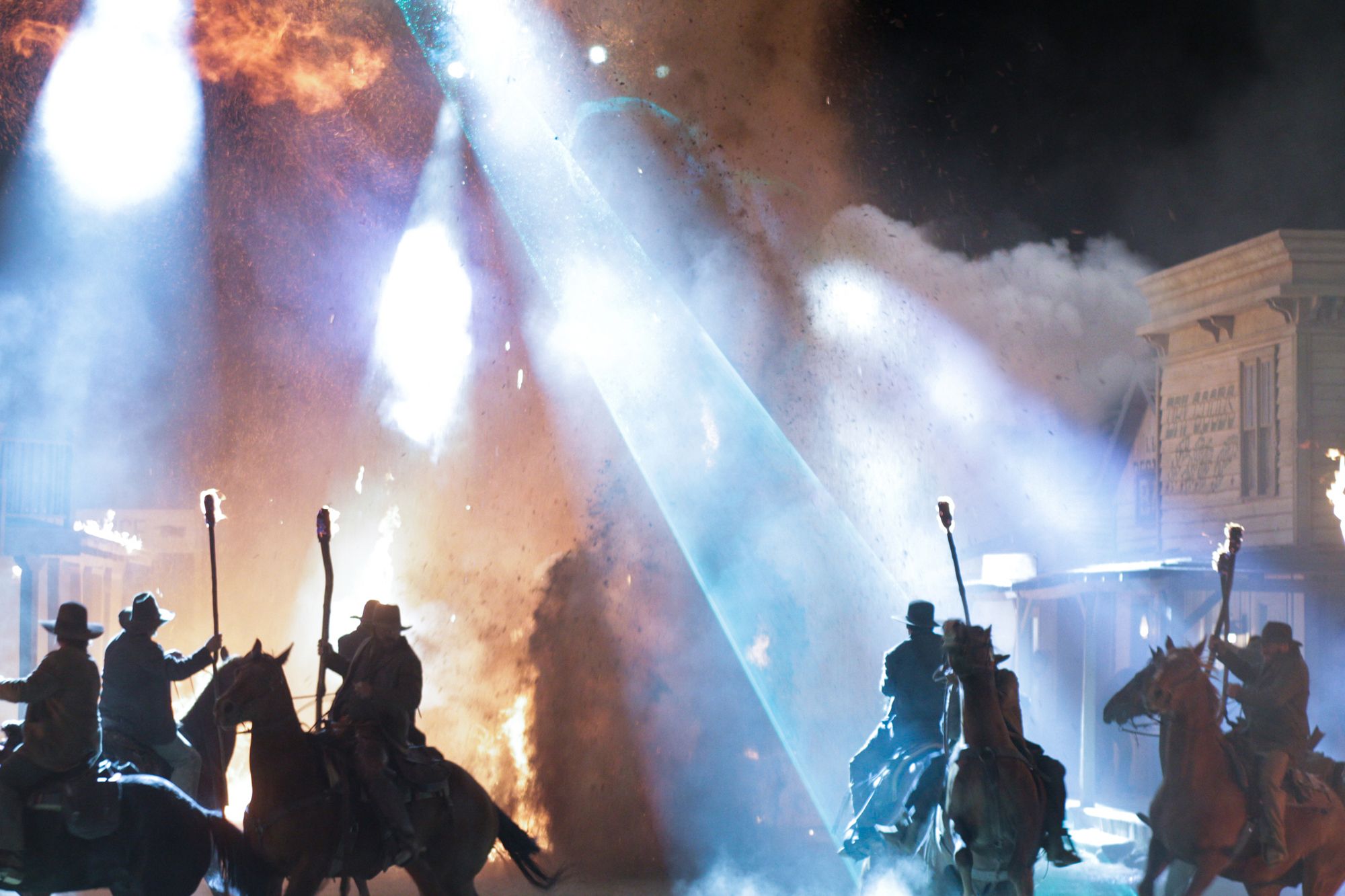Since the film is called Cowboys and Aliens, it only makes sense that the movie is executive produced by three people that know a little something about Westerns and Alien movies, Brian Grazer and Ron Howard (The Missing, Far and Away) and Steven Spielberg (E.T. the Extra-Terrestrial, Close Encounters of the Third Kind). If you think about it, that is a pretty impressive pedigree and sci-fi fans can rest assured that this movie is going to be one that they won't want to miss next summer.
The movie is loosely based on the 2006 graphic novel of the same name created by Scott Mitchell Rosenberg, but it is mostly an original story inspired by the title of the source material. The film takes place in Arizona in the late '1800s and centers around a mysterious loner with no memory of his past, Jake Lonergan, played by Daniel Craig. When he stumbles into a nearby town he realizes that he is actually a notorious criminal wanted by the law and Colonel Woodrow Dolarhyde (Ford), a harsh leader who is in charge of the western community. But when a mysterious force from the sky, which is abducting anyone that gets in its way, attacks the town, Jake realizes that the strange shackle attached to his wrist may hold the key to their salvation. Now, Jake and Dolarhyde must join forces with each other and their former enemies in order to stop the greater threat from above. The film was explained to us as Unforgiven, with Craig in the Clint Eastwood role and Ford as the Gene Hackman part, but before they can fight each other, Independence Day happens. That sounds pretty cool to us!
Last summer we had the pleasure of traveling to the set of the film in Santa Fe, New Mexico to speak with the cast and crew, and have a chance to watch some filming. On the day of our arrival, they were actually shooting the conclusion of the movie. While it was a very exciting scene to witness them film, unfortunately we can't say too much about it, as it would give away the end of the movie. But we can say that most of the cast were involved in this scene, including Craig, Ford, Rockwell, Dano, Carradine and Goggins. We began the day watching some special footage from the film, including the scenes that were shown at last summer's Comic-Con presentation. Again, we can't say too much about the footage other than the fact that it was very impressive and has us very jazzed for the final product.
After we finished watching the clips, director Jon Favreau joined us in the tent where we were gathered, which was adjacent to the set of the hot Santa Fe desert canyon where they were shooting that day. The generous and extremely gracious director surprised us when he began our interview by giving us a gift. "I got started on Iron Man wear we worked with military people a lot and so I had these challenge coins made up," said Favreau. The director went on to explain. "We would work with the Air Force a lot, on Iron Man, Iron Man 2, we were at Edwards Air Force Base. I would shake hands with people, and I would feel like they would stick a coin in my hands and it was a challenge coin. The reason they call it a challenge coin is because if you don't have your unit coin with you when you're out drinking, and somebody taps your glass at the bar, if anybody in the bar doesn't have a coin, they have to buy a round for everybody. But if you challenge everybody and everybody has it, you have to buy the round. But it was also a sign of respect, that they liked the way the crew was and the way we treated them. It was a sign of respect to give a coin. So I had them made up for Iron Man 2. It became like a tradition. So I had them made up for Cowboys and Aliens also. I made them look a little more old school, 'Cowboys' on one side and 'Aliens' on the other and it says, 'Director Jon Favreau.' So sometimes when people visit, we work with people, I'll give them a coin and it's a nice thing because it says you visited the set, you can't get it anywhere else. So I got it for you guys," explained Favreau.
The director went on to discuss how the Western aspect of the film will be handled. "Then for the Western, we really tried to embrace that and not try to update it too much or change it to make it more accessible for a younger audience. We figured that the alien side of things hopefully would take care of the people who don't know the Western, but for people who love Westerns, let's do it using all the archetypes of the classic Western films," Favreau explained. "So we're really trying to do something classic here. Something that feels like it could have been made at an earlier time, except for the technology, but again, using as much practical as we possibly can, then using CGI to help make it look better. As you can see, we're sort of shooting these backgrounds here that a lot of movies would just shoot in a convenient place and put that in. We really found these wonderful locations."
While on the subject of Westerns, we brought up the fact that Craig has a striking resemblance to Steve McQueen in The Magnificent Seven and Favreau had this to say on the subject. "Yeah. He looks remarkably like Steve McQueen did in the 70's. It's interesting, because you think of him as James Bond, but the minute you put him in his whole outfit, he looks like the type of actor that you could cast back in the 60's or 70's," said Favreau. "We looked at films like The Magnificent Seven, but the first meeting I had, along with Bob Orci, Kurtzman and Damon Lindelof, with Steven, he screened The Searchers for us. So I definitely watched and went through all the John Ford films I could get my hands on, also some Sergio Leone. But each era did their version of a very similar structured story type, so we tried to preserve those archetypes in those characters. We figured it's time for our generation to take that class historian, and show it through our perspective."
"There was a big gap, because I don't think people accepted the Western the same way that they had pre-Vietnam, just because it felt a little insensitive, racially, at times, in who the bad guys are and what they represent," Favreau continued. "As archetypes, it all worked very well, but as people became more socially conscious, some people found it distasteful. Then action movies took over, or cop movies, vigilante movies and sci-fi movies would take those archetypes and stick them in space. Now we kind of go back to the old Western and because you now have bad guys that are aliens, it's not racially divisive anymore. Actually we have a story about the Apaches and the cowboys being forced to deal with one another. So we tried to start it off as real as we could historically, and as real as we could, in the context of the traditional Western film. It's interesting to see how these characters are forced to interact with one another based on this looming threat. There was an expression during the Cold War that said the only way Russia and the United States were going to get along and make peace is if a spaceship came and attacked the Earth. You know, a common enemy is an interesting way to examine all those characters in a strained situation, and try to play that out as real as we can," Favreau concluded.
Favreau discussed further the importance of having Howard and Spielberg involved with the project. "Well we had Ron Howard and with The Missing and Far and Away he's certainly a student of Westerns. Spielberg, he's an encyclopedic with his knowledge of it and I think when he was sixteen he met John Ford and got some advice from him," said Favreau. "So I've learned a lot from Spielberg and Ron Howard. You know just talking about film theory, storytelling, or whatever would be exciting; but then hearing stories about what they've tried and how they did it. I'm able to pick their brain about it. How they did it or what's worth exploring now? Then, on top of that sharing the resources of people that they've worked with. It's just been, at this point in my career, it's really a welcomed new layer to add, to be able to actually have people that I can ask questions of and who know so much about making movies."
The director continued to discuss the incredible cast of actors that he has assembled and the importance of having Harrison Ford in the cast. "For this ensemble to be this full with really good actors is remarkable and then to have iconic actors as well. That's very much in the tradition of the Western, as well. When you cast John Wayne, everybody who sat down was like, okay what's John Wayne going to do in this movie? When you cast Harrison Ford, he's bringing that whole tradition of sci-fi and action, and he's always playing a version of a cowboy, even though he's only played one once in his career on film in The Frisco Kid," he said. "But you think of him as a cowboy and he really is, you know? He's an excellent rider, he understands the weapons, he understands the culture, and the rules. See, I don't have all that dialogue. I usually have a fire hose of dialogue to use, whether it's Elf, Swingers or Iron Man. Certainly with Downey and the dialogue, I could always root around through the scene and discover it," Favreau answered.
"But here, it's very simple. A lot of scenes are like one or two, three lines, and a lot of its just looks or gunfights and things like that," the director continued. "It all has to make sense with Western logic, and it's a whole new set of rules that our generation really didn't grow up with like earlier filmmakers, where you were watching it every day and you just understood it. So it's really like learning an old language. The only Westerns I've seen have been revisionist Westerns, certainly recently, except for like Unforgiven or the rare exception. It's usually a sensationalized version of the Western, a new twist on the Western or a Western with an interesting piece of casting that breaks the rules of the Western. But all the way back to, Back To The Future Part III, it just becomes like a fun backdrop as opposed to buying into the whole tradition of it. It's like a song that you're covering. You know it's like, each musician would cover a particular song and it would be done differently. It tells you about that moment in time in music. The Western used to be that. It used to be the same story, Jessie James cleaning up the town. Every generation did its version of that ... Billy the Kid, you know? With each new set of actors, it would reflect that era. So it's fun now, having had nobody really do that, to try to explore that now. As a filmmaker, it's a bit of a luxury," finished Favreau.
"So there's a lot of these guys that, you know, when you say you're doing a Western, people are lining up on the stunt man side and they don't even make Westerns anymore," Favreau said. "There are people who came up doing them. So we have people from all over the country who came out just to be in this because you don't get to make one often. Terry had switched from Westerns to car movies, like the Fast & Furious and stuff. Because in the 70's, they stopped making Westerns and he switched over to being a stunt coordinator for car movies. Now to be able to do a Western, with all the horse falls and all these things that he knows how to do in his sleep, it's great to have that resource to tap into."
Favreau also spoke to us about why he likes directing big, budget Hollywood movies like Iron Man and Cowboys and Aliens. "I like working on these big movies because if you get it wrong, the filmmaking, you still have all of the great, beautiful window dressing, and it probably will make its money back," joked the director. "So there's that safety net that you don't have with independent films. But if you could get that part right, then you could actually tell a story and make people feel something in a movie like Cowboys and Aliens. You could have some humor or add some humanity to it. Then I think the audiences will really reward you and they'll embrace the film. It'll become one of those movies that somehow lasts the test of time and people will check it out later, when it comes on television in a few years. But I like the idea that it's just Cowboys and Aliens people are going to see. They think that they're just going to see a summer romp and hopefully they will see something a little more special."
Since the film is based on a comic book, albeit one that is not as widely known as Iron Man, we asked Favreau if he feels more freedom adapting this graphic novel as apposed to his previous work on the Iron Man movies? "Yeah, I mean, honestly I was exposed to it. I knew the title and I knew the image of a cowboy running away from a flying saucer, it's pretty cool. Then Mark Ferguson and Hawk Ostby, who wrote Iron Man, had been attached to the film when I was shooting Iron Man. I had heard about it, and had a meeting with Spielberg about it because I thought it sounded really cool," he explained. "Then for a while, Downey had even met and was attached to it, before Sherlock Holmes II happened. So I heard about it again. Then I met with Kurtzman and Orci at Comic-Con last year. We had a general meeting and they mentioned that that was one of their projects. I said that that was one I'd always heard about and that Downey had been attached. They sent me the script and it was a real page-turner. It was nice to have a piece of material before we ever started the casting or prepping and it was a very strong script. So I don't know that much about the comic book, but I do know that we definitely reinvented things from the images that I've seen."
Be sure to check back with us later this week for part two of our visit to the Cowboys and Aliens set where we spoke to one of the film's writers Roberto Orci, as well as actors Sam Rockwell and Paul Dano, took a tour of the set and even had a brief encounter with a living legend!





